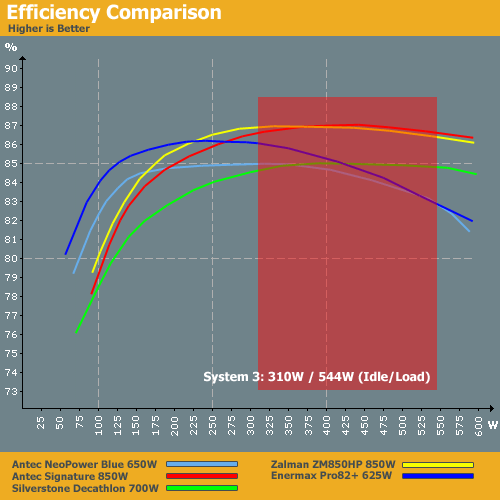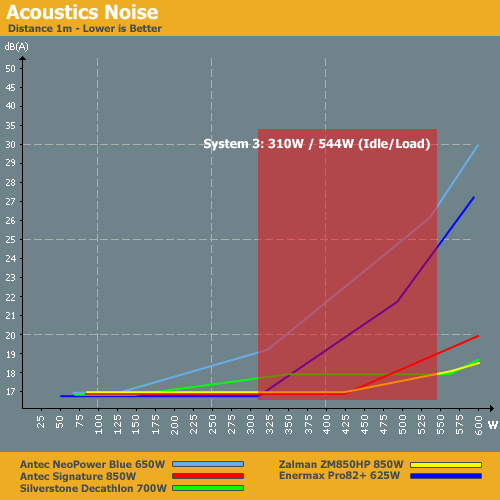Debunking Power Supply Myths
by Christoph Katzer on September 22, 2008 3:00 AM EST- Posted in
- Cases/Cooling/PSUs
PSUs for High-End Systems
Even though our high-end system consumes more power, we used the same graph layout. That means the resulting graphs stop at 600W, despite the high-end PSUs all being capable of providing more power than that. Our high-end system sports an SLI setup using two NVIDIA 8800 ultra cards; 3-way SLI would be a bit more demanding, but we don't feel it's a good indication of what people are actually running. The third card would also only add another 50W to 90W of power consumption to our system, since the third card is rarely taxed as much as the first GPU.
- Antec NeoPower Blue (650W) actively cooled
- Antec Signature (850W) actively cooled
- Silverstone Decathlon (700W) actively cooled
- Zalman ZM850HP (850W) actively cooled
- Enermax Pro82+ (625W) actively cooled

We've included the Enermax Pro82+ 625W from the midrange selection as well. Again, efficiency is not the major issue when it comes to choosing between these products. The two lowest rated power supplies -- Antec NeoPower 650W and Enermax Pro82+ 625W -- are less efficient over the tested range, but that's expected. The results all of her around 85% to 87% mark, and one or 2% difference really isn't going to matter much. Still, the Zalman and Antec 850W units place at the top of this chart.

Again, the two power supplies with the lowest output rating perform worse in this test, generating much more noise than the competition. The higher rated units don't have to work as hard, since they are running at a medium load. Those three PSUs remain very quiet along with providing better efficiency, making them the better for a high-end setup. The Zalman and Antec Signature 850W units would be our choice, if only for the extra headroom. Either PSU would have no difficulty with a 3-way GPU setup, provided you have sufficient PEG connections available. That brings up the next topic of discussion.










98 Comments
View All Comments
BernardP - Monday, September 22, 2008 - link
The following paragraph from the article has me puzzled:"It's important to have one 12V rail supply the CPU with power and the second rail for the PCI-E slots and 6-pin connector. Unfortunately, many companies make a tremendous mistake when it comes to power distribution. We have seen several power supplies that use one 12V rail for the 6-pin PEG connector and then a second 12V rail for the CPU and 24-pin ATX connector. That means if you have a graphics card that doesn't include a 6-pin jack, both the CPU and GPU will use the same 12V rail for power. In this case, the second 12V rail goes completely unused, and users risk drawing too much current on the remaining 12V rail."
I have an Antec Eartwatts 380. How can I find out if Antec has made the tremendous mistake or not? I want to make sure that the 6-pin connector and PCI-E slot are on their own 12V rail. Antec litterature on this PS says:
"Dual 12V outputs: 12V2 for motherboard and peripherals, 12V1 for processor"
It would seem OK, assuming "peripherals" includes the 6-pin connector.
7Enigma - Monday, September 22, 2008 - link
What is your graphics card? From the article it seems to me they are saying if you do NOT have a card that requires a 6-pin PEG connector then you could possibly have an issue. If you have a card requiring a PEG connector you don't have to worry.BernardP - Monday, September 22, 2008 - link
Exactly. I am planning to add a 9500GT to my existing system (integrated graphics). No power connector on that card.Dribble - Monday, September 22, 2008 - link
http://extreme.outervision.com/powercalc.jsp">http://extreme.outervision.com/powercalc.jspSeems to return sensible values, and not only does it cover pretty well every component you might come across, but it also understands overclocking, over volting, and allows you to enter a value for capacitor ageing.
Also, here is a thread which someone has helpfully listed real power requirements (as given in reviews) for pretty well all graphic cards on the market right now:
http://archive.atomicmpc.com.au/forums.asp?s=2&...">http://archive.atomicmpc.com.au/forums.asp?s=2&...
drank12quartsstrohsbeer - Monday, September 22, 2008 - link
Hey Guys: Remember that decibels is a logrithmic scale of measurement! Using a linear scale on the graph leads to inappropriate conclusions being drawn from the data.7Enigma - Monday, September 22, 2008 - link
I don't think it does. Maybe a quick *note* at the beginning of the acoustics section mentioning its logrithmic, but it is very easy to read a linear scale.Also, the majority of the tested systems fall well below the floor of most systems (20 decibels), so it is a moot point anyway.
gmkmay - Monday, September 22, 2008 - link
I'll start off by saying good article, however I would have liked to see a few additions.Other than the aforementioned new cards and overclocking information I think it would have been helpful to include common watercooling pumps and case/system fans. There is most likely a large enough set reading this that would have liked to see those added.
The problem with the power supply issue is you have to be really careful not to get something too weak...and its really easy to forget a few small items that can quickly add up (for instance 2 pumps, 8 120mm fans, etc).
mindless1 - Thursday, September 25, 2008 - link
Nobody building a PC needs 8 x 120mm fans. Let's suppose you throttle down the fans enough that you might actually have good use for so many to have them all at very low RPM. That would tend to cause under 150mA per fan or barely over 1A total, a relatively trivial amount of power considering that even spinning up any one hard drive causes a larger momentary spike.A couple pumps shouldn't use all that much power either, but if you're pouring enough money into the system to have it that elaborate then why would you be on the fence about choosing a marginally capable PSU versus one with plenty of reserve power to the point where 3A one way or the other isn't a factor?
Anubis - Monday, September 22, 2008 - link
would be interesting to see numbers on just how much power OCing pulls over a non OCed systemChristoph Katzer - Monday, September 22, 2008 - link
I had a QX9770 just slightly overclocked with basic bios functions (for an oc-noob like me) and already then it had an increased power draw of 20% at full load compared to normal.